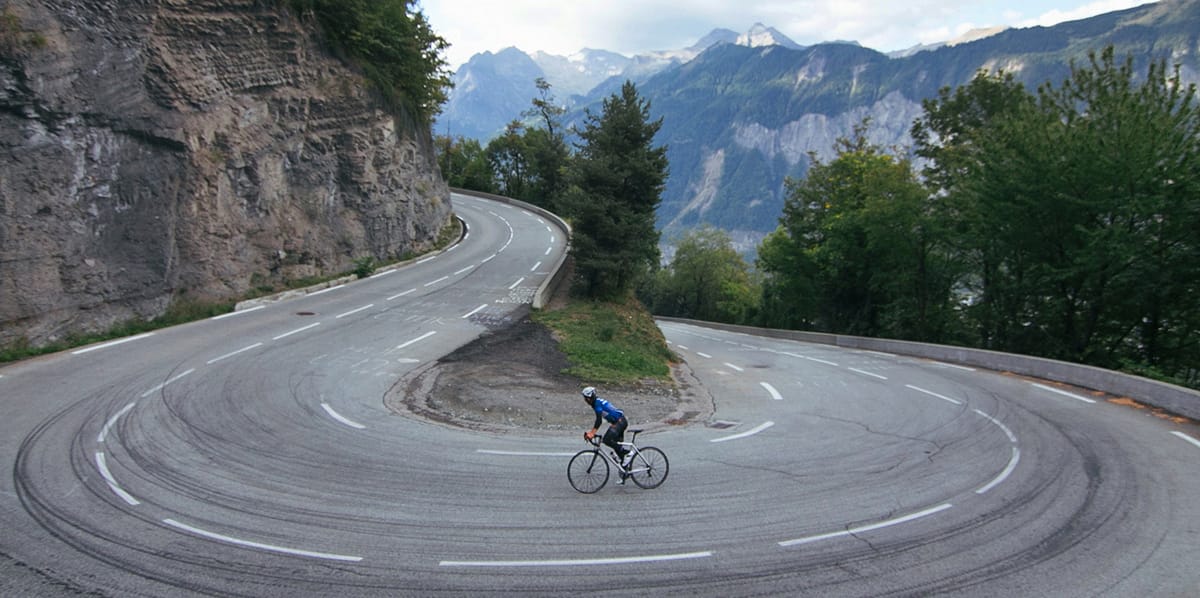Rider Review
One of the giants of world cycling, Alpe d’Huez is not the most beautiful or difficult but it is pure cycling theatre and a climb that no other can match in terms of Tour de France drama. Set in the stunning Oisans region, Alpe d’Huez is in the heart of the cycling world with the Glandon, Galibier, Lauteret, Sarenne & Izoard all nearby as well as some great lesser known climbs. The Tour comes to Alpe d’Huez roughly every other year so the road is always full of recent grafitti cheering on the main riders. Each of the 21 corners is marked with the name of one of the stage winners. In 2013, for the first ever time the stage took in two ascents of the Alpe with a descent of the nearby Col de Sarenne in between.
When to Ride Alpe d’Huez
The climb goes up the D211 to the ski resort so is open all year round and very well maintained. The resort is open in the summer from June to late Aug / early Sept when most of the hotels, restaurants and cafes are open but all year round there is some life in town. The best weather for riding tends to be early June to early July, and then again from mid August to mid September. In the peak summer weeks there is an organised time trial up the climb every Wednesday night (the day of the week can change each year)

Riding Alpe d’Huez
With any climb, context is everything. I once asked the great Sean Kelly what his hardest climb was and he said Alpe d’Huez, because he was riding it at the end of a long Alpine stage where everyone was ripping the legs off each other. For the sportive rider, the experience is similar at the end of the Marmotte with the Glandon, Telegraph & Galibier in your legs and the high probability of afternoon heat to deal with.
The climb starts just out of Bourg d’Oisans (the climb is well sign posted) and from any direction you have a few km of flat or slight downhill into the climb. After passing a campsite on your left, the road bends left and you are on the climb. The average gradient throughout the 12km is 8% and for the majority of the way up, this stays very consistent so you can find a rhythm. However, the first two hairpins are the steepest at over 10%. These first two sections are also among the longest, about 750m each and the town below disappears rapidly below you. Throughout the climb the corners are flat enabling you to go wide and get your cadence up for the next steeper straight.
By the time you get to turn 20, the gradients settle in to 7 to 9% and the hairpins get closer and closer all the way to turn 7 at the famous Dutch corner. On any day in cycling season you will see riders from all over the world and normally a lot from Holland. In early June, hundreds of Dutch rides take on the Alpe d’Huzes, a charity event where the challenge is to climb Alpe d’Huez as many times as possible in a day and during the Tour the whole area is full of Orange clad fans.
From Dutch corner it is 1km to the village of Huez with a sharp section out of town before the gradients ease up and the scenery becomes prettier with snow capped mountains above and cowbells ringing from happy cows grazing in lush Alpine pastures. Make sure to stay straight on the road (D211) rather than taking the right turn up to Bergers and you will hit turns 3, 2 & 1, all averaging between 5 & 6% so you can finish in the big ring if you are feeling good and spinning nicely if getting up the climb is your aim. After turn 1, the finish is 750m up the road as you get into Alpe d’Huez resort. In the cycling season, there is a podium where you can get a photo and a number of cafes where you can grab a well earned drink before the fun descent down.
More than any other climb, your time up Alpe d’Huez matters! Under one hour is very strong, anything under 1hr30 is respectable. While it may not be the most spectacular climb for scenery, there is something magical about Alpe d’Huez and should be right at the top of any rider’s bucket list.

